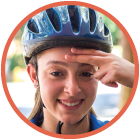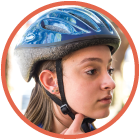Campus community members may ride in designated bike lanes when traveling around campus and Inner Ring Road. It is important to be aware of pedestrians crossing through Aldrich Park. Riding bicycles, scooters, and like devices is not permitted on Ring Mall between 8:30 a.m. and 5:00 p.m. Monday through Friday.
Riding a bike or scooter on sidewalks is prohibited on the University campus except in those few areas where no parallel roadway or bike path exists. Bicycles, scooters, and skate devices at UCI may not be operated in any landscaped areas, pedestrian corridors, pedestrian ramps, or anywhere signs are posted prohibiting riding.
Bicyclists and scooters must obey all posted speed limits. Additionally, no bicyclist or scooter may travel at a speed greater than is reasonable and prudent under existing conditions. At the University, the speed limit on campus bike paths is 8 mph.
Operating a bicycle, scooter, or skate device while under the influence of alcohol or drugs is punishable by fines, jail time, and/or loss of driving privileges. It is also illegal for two persons to ride on a bicycle, scooter, or skate device meant for one or to have earphones covering both ears while riding a bicycle or scooter.
Visit the official university policies and procedures regarding bike, scooter, and skateboard use on campus.
Safety Procedures
-
- Only ride in designated bike lanes – shared pathways are marked, and bicyclists and scooters should use the appropriate bike lane whenever possible.
- Ride single-file – Ride in a straight line about a car door’s width away from any parked cars.
- Pass with caution – Only pass on the left and alert the people around you. Say “On your left” as you are about to pass.
- 3 feet law – When riding next to cars, allow at minimum 3 feet of space between your handlebars and the edge of the vehicle’s side-view mirror.
- Ride at a safe, reasonable speed – Consider the flow of bicycle, scooter, and pedestrian traffic and other bike path conditions.
- Don’t weave between cars – Avoid riding near the curb between parked cars. Motorists may not see you when you try to move back into traffic.
- Follow lane markings – Do not turn left from the right lane. Do not go straight in a lane marked “right turn only”; stay to the left of the right turn only lane if you are going straight.
- Choose the best way to turn left – There are two ways to make a left turn:
- Like a motorist: Signal, move into the left lane, and turn left. In a left turn-only lane, stay to the right of the lane to allow any motorists behind to make their turn on your left.
- Like a pedestrian: Ride straight across to the far-side crosswalk, dismount, and walk your bike across.
- Whenever possible, avoid travel during peak travel times – Congestion occurs during the change of classes. You will find the bike paths enjoyably empty during class time.
Protect Your Investment – Wear a Helmet
-
- Significantly reduce your risk of head injury per the Bicycle Helmet Safety Institute.
- When adjusting your helmet, remember to check your:
HELMET POSITION

You should be able to fit two fingers between your eyebrow and helmet.
SIDE STRAPS

Side straps need to join right below your earlobes.
CHIN STRAP

Chin straps should be snug, with room for only one finger.
Helmet Giveaway
Earn a FREE helmet while supplies last by taking our brief Helmet Survey!
Be Visible At Night
Lights and reflectors are required by law after dark to ensure that you remain visible to other bicyclists, scooters, pedestrians, and vehicles.
-
- Wear high-visibility clothing – Add reflective gear to your clothing to increase your ability to be seen by others.
- Add lights – Lights increase your visibility to others and allow you to safely see the road ahead of you. Flashing front, rear, and ankle lights have the added benefit of attracting more attention than static lights for passing vehicles.
- Maintain your bike reflectors and add reflective tape – While most bicycles already come equipped with reflective surfaces, you can add reflective tape to your helmet, bike, rims, and pedals for added safety.

Obey Signals and Signage
-
- Obey traffic laws – Bicyclists and scooters are required to stop at traffic lights, stop signs, and yield signs.
- Watch for pedestrians –Use caution when approaching pedestrian crossings and stop if there is a stop sign, traffic signal, or yield sign.

Use Hand Signals
- Hand signals tell everyone what you intend to do.
- Signal as a matter of law, courtesy, and self-protection.

How To Utilize Proper Hand Signals
-
- Left Turn: Fully extend your left arm out to the side.
- Slowing or Stopping: Extend your left arm out at a right angle with your hand open and pointing down.
- Right Turn: Bend your left arm up at a right angle with your hand flat or fully extend your right arm out to the side.
Be sure that before changing lanes or making turns you are scanning your surroundings by looking over your shoulder.
Fit Your Bike To You
Properly make basic adjustments to your bike to:
-
- Reduce the risk of injury
- Ensure a more comfortable and efficient ride